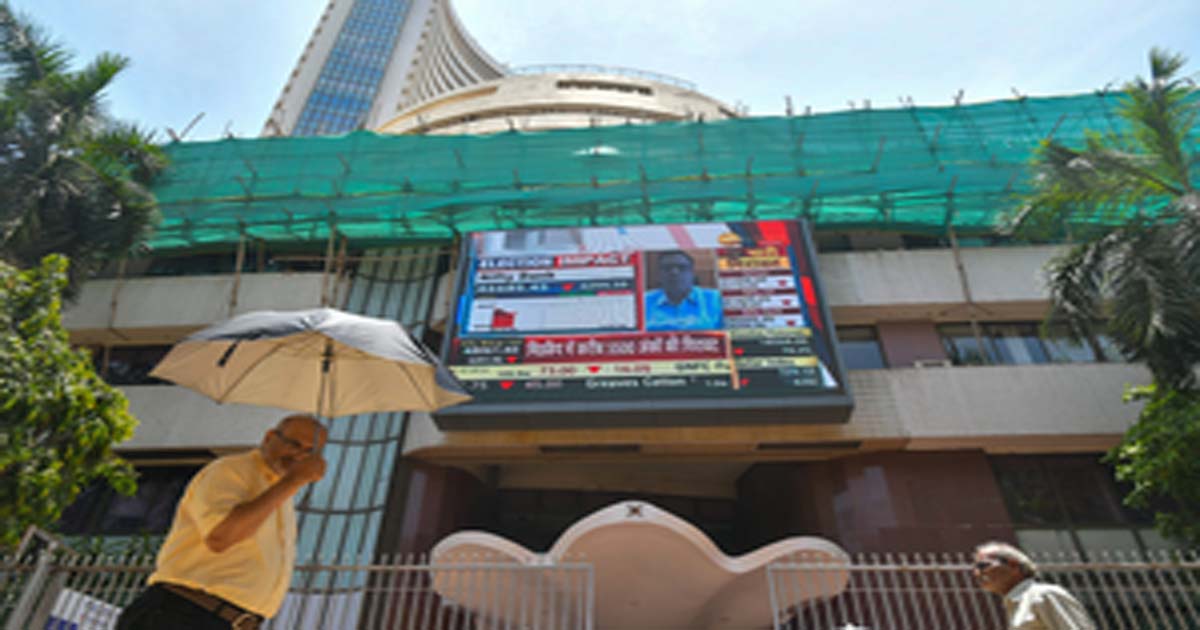Business
Indian stock market opens flat amid stable institutional investments

Mumbai, May 30: The domestic benchmark indices opened flat on Friday amid negative Asian cues, as selling was seen in the IT and auto sectors in the early trade.
Stable institutional flows — both FII and DII — are keeping the market steady even in the absence of positive triggers. The ongoing consolidation phase is likely to continue in the near-term, according to analysts.
At around 9.29 am, Sensex was trading 11.77 points or 0.01 per cent up at 81,644.79 while the Nifty added 13.20 point or 0.05 per cent at 24,846.80.
Nifty Bank was up 81.20 points or 0.15 per cent at 55,627.25. The Nifty Midcap 100 index was trading at 57,707.65 after rising 250.40 points or 0.44 per cent. Nifty Smallcap 100 index was at 17,927.15 after climbing 37.75 points or 0.21 per cent.
According to analysts, the Nifty posted a smart recovery in the final minutes of trading on Thursday, after spending most of the first half in the red.
“Although the Nifty is still caught in a sideways market defined by the 24,462 and 25,116 range, yesterday’s rebound traced a long lower shadow and a small real body that was closer to the day’s high, and that’s a bullish sign. Immediate support and resistance lie at 24677 and 25000 respectively,” said Akshay Chinchalkar, Head of Research at Axis Securities.
Meanwhile, in the Sensex pack, Infosys, Tech Mahindra, HCL Tech, Bajaj Finance, IndusInd Bank, Bharti Airtel, Titan and Hindustan Unilever Limited were the top losers. Whereas, Adani Ports, Eternal, Maruti Suzuki and Sun Pharma were the top gainers.
In the Asian markets, Hong Kong, Bangkok, Seoul, China and Japan were trading in the red.
In the last trading session, Dow Jones in the US closed at 42,215.73, up 117.03 points, or 0.28 per cent. The S&P 500 ended with a gain of 23.62 points, or 0.40 per cent, at 5,912.17 and the Nasdaq closed at 19,175.87, up 74.93 points, or 0.39 per cent.
“Investors should understand two distinct big trends that will weigh on markets: One, India’s macros are strong and improving. Two, this positive trend in macros is not getting reflected in corporate earnings,” said Dr VK Vijayakumar, Chief Investment Strategist, Geojit Investments Ltd.
This is the fundamental reason for the range-bound movement of the market.
On the institutional front, foreign institutional investors (FIIs) were net buyers as they bought equities worth 884.03 crore on May 29, while domestic institutional investors (DIIs) purchased equities worth 4,286.50 crore.
According to market watchers, steadily improving macros like resilient GDP growth, down trending inflation and interest rates and declining fiscal and current account deficits lay the foundation for a strong economy and earnings recovery in the medium term.
Business
FIIs return to Indian markets, pump in over Rs 10,000 crore in October

Mumbai, Oct 16: After months of selling, foreign investors seem to be regaining confidence in Indian stock markets as the data from NSDL shows that between October 7 and October 14, Foreign Institutional Investors (FIIs) were net buyers in five of the last seven trading sessions, purchasing shares worth over Rs 3,000 crore in the secondary market.
Their buying in the primary market was even stronger, crossing Rs 7,600 crore, as per the data.
Provisional data from the NSE also indicates that FIIs continued their buying streak on October 15, adding another Rs 162 crore.
This renewed buying interest has come alongside a steady rise in key market indices.
Since the beginning of October, both the Sensex and Nifty have gained around 3 per cent, while the BSE MidCap index has climbed 3.4 per cent and the SmallCap index has advanced 1.7 per cent.
The sudden shift in foreign fund flows has surprised many market watchers. Some analysts see this as a short-term rebound, while others believe it reflects improving corporate earnings prospects and stabilising economic conditions in India.
This turnaround is a sharp contrast to the heavy outflows seen earlier this year. From January to September 2025, FIIs sold more than Rs 2 lakh crore worth of shares in the secondary market.
This happened even as the Reserve Bank of India and the government took several steps to support growth, including GST rate cuts, a steep repo rate reduction in June, and an upgrade in India’s sovereign credit rating by S&P.
During that time, Indian markets lagged behind global peers. The Sensex and Nifty rose only about 3 per cent, while the MidCap and SmallCap indices fell 3 per cent and 4 per cent, respectively.
Now, sentiment is improving on hopes of a possible India–US trade deal amid growing US–China tensions.
Expectations of a US Federal Reserve rate cut later this month are also fueling optimism, as it could bring more liquidity into emerging markets and commodities.
Experts believe India remains an attractive investment destination for global investors, supported by a weaker rupee, relatively modest valuations, and expectations of double-digit earnings growth for Nifty companies in the second half of FY26.
Business
Sensex, Nifty open higher on positive global cues

Mumbai, Oct 15: Indian stock markets opened on a positive note on Wednesday, taking cues from the upbeat global sentiment.
The Sensex climbed 243 points, or 0.30 per cent, to trade at 82,273, while the Nifty rose 79 points, or 0.31 per cent, to start the day at 25,225.
Commenting on the Nifty’s technical outlook, experts said that though the 20-day SMA stepped in yesterday, to limit the extent of the drop, we prefer to give more weightage to the bearish engulfing pattern, thus acknowledging the prevailing bearish bias.
“Meanwhile, we remain equally prepared to switch sides, if Nifty manages to push beyond 25230. However, we will wait for a break beyond 25330 to play directional upsides,” they added..
Buying was seen across most sectors, with heavyweights like Bajaj Finserv, Bajaj Finance, NTPC, L&T, Power Grid, BEL, Bharti Airtel, Trent, and Asian Paints leading the gains. These stocks moved up by as much as 1.2 per cent in early trade.
However, some pressure was seen in select counters such as Tech Mahindra, Axis Bank, Infosys, and Titan Company, which slipped up to 1.2 per cent.
In the broader market, the Nifty MidCap index gained 0.38 per cent, while the Nifty SmallCap index advanced 0.20 per cent — indicating a positive trend beyond the frontline indices.
Among sectoral indices, Nifty IT and Financial Services rose 0.6 per cent each, while PSU Bank and Realty indices also traded higher — reflecting a broadly optimistic market mood.
Experts said that investors are likely to track global market trends, crude oil prices, and institutional flows for further direction.
“In the current environment of heightened volatility and mixed market cues, traders are advised to maintain a cautious “buy-on-dips” approach, particularly when using leverage,” analysts said.
“Booking partial profits during rallies and maintaining tight trailing stop-losses is recommended to manage risk. Fresh long positions should be considered only if the Nifty sustains above the 25,300 mark,” they added.
Business
Explained: EPFO overhauls withdrawal rules to boost transparency, ease access for 30 crore members

New Delhi, Oct 14: The Employees’ Provident Fund Organisation (EPFO) has restructured its partial withdrawal regulations, combining 13 distinct clauses into three main categories: Essential Needs, Housing Needs, and Special Circumstances. This change aims to make it easier to access provident fund savings.
For the nearly 30 crore members who collectively own a corpus of about Rs 30 lakh crore, the reform aims to make the withdrawal process quicker, simpler, and more transparent.
The revised framework, referred to as EPFO 3.0, has standardised withdrawal limits.
Depending on the goal, members can now access up to 100 per cent of their eligible provident fund balance, which includes employer and employee contributions. However, at least 25 per cent of the EPF balance needs to stay in the account in order to maintain a safety net for retirement.
This implies that members can keep the required balance while withdrawing up to 75 per cent of their total corpus.
Additionally, the new regulations standardise the requirements for services. In the past, there were specific requirements for each type of withdrawal, such as five years of service for housing purposes and seven years for marriage-related withdrawals.
All partial withdrawals are now subject to a single 12-month minimum service period, which streamlines the procedure and removes any ambiguity.
Members will no longer need to provide documentation of their withdrawals under the “Special Circumstances” category, which is a significant relaxation. In the past, withdrawals under this heading required proof of emergencies, such as natural disasters or job loss.
The new clause, which permits members to leave without giving a reason, is anticipated to reduce red tape and expedite approvals.
The EPFO has also increased the withdrawal limits for marriage and education-related withdrawals. Instead of the previous cap of three combined withdrawals, members can now make up to 10 withdrawals for education and five for marriage.
Stricter guidelines for final settlements are also introduced by the reforms, though. In contrast to the previous two-month eligibility window, members can now only apply for an early final settlement 12 months after quitting their job and for pension withdrawal 36 months later.
In the event of a job loss, the 25 per cent minimum balance requirement only applies to partial withdrawals; it does not apply to full settlements.
While it is anticipated that the simplified framework will increase efficiency and transparency, workers who are laid off or have experienced extended periods of unemployment may find it difficult to obtain their provident fund savings immediately during a time when they may need it most, due to the revised settlement timelines.
-

 Crime3 years ago
Crime3 years agoClass 10 student jumps to death in Jaipur
-

 Maharashtra1 year ago
Maharashtra1 year agoMumbai Local Train Update: Central Railway’s New Timetable Comes Into Effect; Check Full List Of Revised Timings & Stations
-

 Maharashtra1 year ago
Maharashtra1 year agoMumbai To Go Toll-Free Tonight! Maharashtra Govt Announces Complete Toll Waiver For Light Motor Vehicles At All 5 Entry Points Of City
-

 Maharashtra1 year ago
Maharashtra1 year agoFalse photo of Imtiaz Jaleel’s rally, exposing the fooling conspiracy
-

 National News1 year ago
National News1 year agoMinistry of Railways rolls out Special Drive 4.0 with focus on digitisation, cleanliness, inclusiveness and grievance redressal
-

 Maharashtra11 months ago
Maharashtra11 months agoMaharashtra Elections 2024: Mumbai Metro & BEST Services Extended Till Midnight On Voting Day
-

 National News1 year ago
National News1 year agoJ&K: 4 Jawans Killed, 28 Injured After Bus Carrying BSF Personnel For Poll Duty Falls Into Gorge In Budgam; Terrifying Visuals Surface
-

 Crime1 year ago
Crime1 year agoBaba Siddique Murder: Mumbai Police Unable To Get Lawrence Bishnoi Custody Due To Home Ministry Order, Says Report












